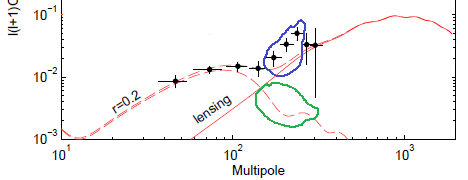Posted: Mar 18, 2014 2:49 pm
lpetrich wrote:Jester blogs on this finding: RÉSONAANCES: Curly impressions"If this holds" is the central question now. This sort of experiments is difficult and subject to pesky instrumental effects and systematic effects due to foreground emission. It's not impossible that BICEP screwed up; in fact, experts point out some worrying aspects of the data, for example the excess in the BB spectrum at high multipoles. So I would say at this point it's fifty-fifty. Fortunately, there are many experiments out there with similar sensitivity (Planck, ACTPole, SPT, POLARBEAR) that should be able to confirm or refute the claim in the near future. In particular, the release of Planck polarization data this year should straighten many things out.
He's talking about the three data points in the blue region that are higher than the expected value:

As noted on Matt Strassler's blog, these seem to be statistical flukes. He writes:
However, this point was addressed by the BICEP2 folks in their presentation. Their view is that (1) the high data points are not very statistically significantly high, and (2) with new data that they haven't released from their third-generation experiment, they don't see the same effect. So this is presumably what gives them confidence that the excess is a temporary, statistical fluke that will go away when they have more data.
So apparently, the anomalies will disappear when the new data is added. That's not surprising, because the initial data of an experiment is biased to overestimated values, since flukes above the actual value are easier detected than flukes below the actual value. All data points will probably be adjusted downward as the data become more robust.